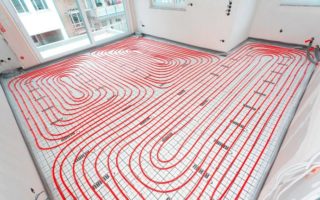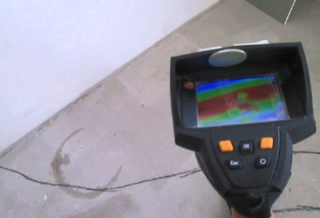The construction of electric underfloor heating is reliable enough to serve its owner within the stipulated warranty period. The latter depends on the particular manufacturer and averages at least ten years. After this time, the identification of possible malfunctions in the system and the subsequent repair of the warm floor are carried out at their own expense.
The principle of operation of the underfloor heating system
Any electric heating system contains the following required elements:
- a heating cable that converts electrical energy into heat;
- a temperature regulator (thermostat) that controls the operating modes of the system;
- temperature sensor (sensitive element);
- a foil substrate that acts as a heat reflector.
Like a water system, electrical elements are mounted in a screed of a subfloor or under any finishing surface, including concrete, tile, linoleum or wood. Unlike the pipes with water carrier laid in the screed, the electrical structure is a set of special conductors (electrically conductive cores), laid out in a certain order. Through the control unit, they are connected to the contacts of the apartment electrical network with an operating voltage of 220 volts.
The principle of operation of the electric floor heating system is as follows:
- When current flows through the busbars, the latter heat up to a certain temperature.
- Electric energy is converted into heat, which is explained by the large resistivity of cable cores.
- Due to high-quality contact with heated surfaces, heat is transferred to surrounding objects with the least possible loss.
In certain conditions, for example, in case of violation of the operating rules, the debugged heating system may break, a need arises to repair the electric underfloor heating.
The main types of malfunctions
The following malfunctions occur during the operation of electrical systems:
- damage (breakage) of the cable or individual wire included in its composition;
- failure of the electronic temperature controller;
- a problem with the supply voltage;
- rupture of the cable sheath (insulation).
The first of these problems occurs due to accidental deformation and rupture of the copper core, which disrupts the energy supply chain of the entire system. The second reason happens less often, however, no one is immune from marriage or accidental breakdown of the thermostat.
Power problems are the most common causes of structural failure due to a trip by the current protection system. A break in the cable sheath is similar to the first malfunction, but in this case the circuit is disconnected due to the presence of earth leaks. Malfunctions of water floors are reduced mainly to the appearance of leaks formed in the places of arrangement of fitting joints. It is also possible accidental damage to pipes due to careless actions during work carried out on a fine floor.
Do-it-yourself restoration of underfloor heating
If the underfloor heating is punched in order to repair it, you should look for a place of possible damage. To make sure that the cause of the malfunction is precisely this - you should ring the cable through a special measuring device - a multimeter.When the central conductor rings, it is able to confirm only a break, it is impossible to establish the exact place of wire break in this way. You will need special devices designed to search for hidden electrical wiring. When they move along the cable laying path at the point of breaking the electric circuit, the device will give an audio or light signal.
It is necessary to remove the flooring in the place where a breakdown is detected, and then carefully disassemble the concrete screed in this area. After contact restoration, the cable in this place is reliably insulated, and then checked for operability. If the check shows a positive result, the flooring in this place can be restored.
A situation is possible in which the electric floor does not heat up to the desired temperature set on the electronic controller. One of the reasons for this is poor contact in the terminal strip of the device itself. During repairs, check the screw connections and tighten them if necessary. You should also check the temperature sensor itself, which allows using the exclusion method to verify the malfunction of the temperature controller.
If all the remaining elements of the system are working, simply replace the thermostat with a new product.
Another reason for the temperature controller to trip is the improperly selected sensor mounting location. If it is close or too far from the heating cable, the actual temperature inside the coupler and the readings of the device may differ by 2-3 degrees, which will lead to a false response of the protection system.
Repair of water floors, as a rule, comes down to replacing a damaged section of a pipe, or to updating a leaking fitting joint.
User manual
The operating rules for the underfloor heating kit are detailed in the instructions attached to it. Before starting, you should carefully study the list of requirements.
- Work on the restoration of the warm floor, as well as partial replacement of heating cables and thermostats, are carried out only after the power line is turned off.
- During operation, no large objects or thick coatings that interfere with normal heat transfer should be located in the served room. If these requirements are not observed, cable overheating and complete system failure can occur.
- The floor surface should not be exposed to significant mechanical stresses that threaten the state of the temperature sensor and the heating cable itself (film element).
- Upon detection of malfunctions or malfunctions in the system, the circuit breaker responsible for the supply of electricity is turned off. Immediately after this, they turn to the specialists of the service center.
- With a long absence in the living room, when the warm floor remains completely unattended, the electric power should be completely removed.
If the underfloor heating system is the main source of heat in the house, with a prolonged absence of people, a mode with minimum temperature indicators is set.






